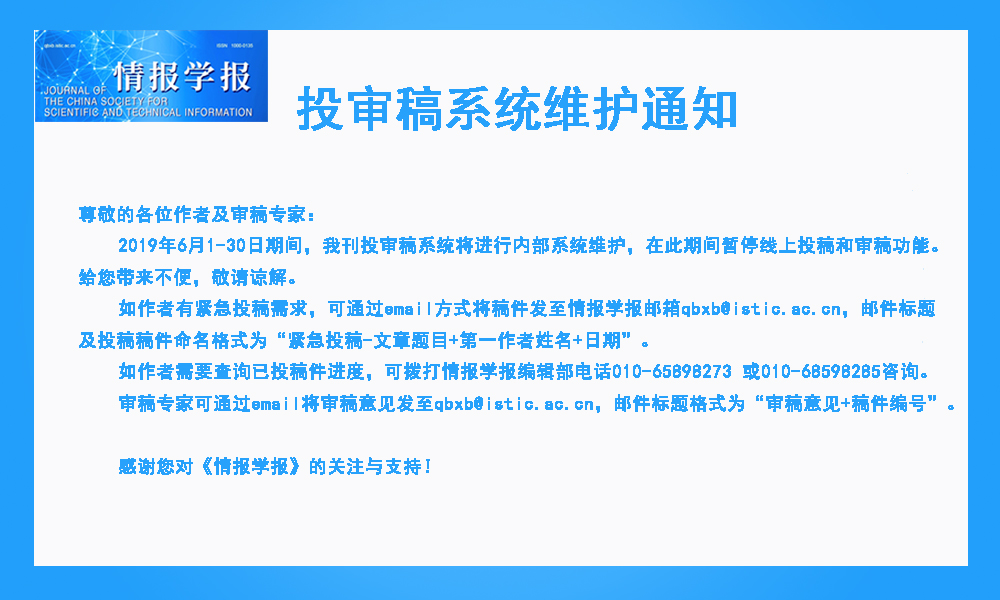 |
|
2019 Vol. 38, No. 8
Published: 2019-08-28 |
|
|
| |
|
|
|
|
|
778 |
Application Value of Competitive Intelligence Research Based on a Double-Visual Group Model Hot! |
|
 |
Zhou Xinyu, Ma Xiaoqi |
|
|
DOI: 10.3772/j.issn.1000-0135.2019.08.002 |
|
|
In order to demonstrate the value of the advanced application of competitive intelligence, this paper proposes a dual-view group model. Firstly, based on the micro/macro relativity and static/dynamic absolute value of competitive intelligence, the Theory of Planning Behavior (TPB), the Graph Model for Conflict Resolution (GMCR), and the Porter Diamond model, which have similar perspectives and analytical processes, are selected as the components of the dual-view group model. Secondly, through the combination of the mechanisms of competitive behavior stated by TPB and empirical information, the behavioral preferences of decision-makers in competitive events are evaluated, and GMCR simulation is used to predict the state evolution under specific conditions, which provides policy references for participants. Then, by comparing the final state with the expectations of the research objectives, the Porter Diamond model is used to formulate a strategic policy to cultivate the core competitiveness of the decision-makers. In the empirical analysis, the author uses this method to realize competitive prediction and scientific decision-making, which have a high degree of agreement with the actual situation. Therefore, the group model can be used to show the value of competitive intelligence to advance the application. |
|
|
2019 Vol. 38 (8): 778-785
[Abstract]
(
255
)
HTML
(89 KB)
PDF
(991 KB)
(
522
) |
|
|
|
786 |
Definitionand Quantification Methods of Citation Takeoff Hot! |
|
 |
Zhang Jingwen, Sun Jianjun, Min Chao |
|
|
DOI: 10.3772/j.issn.1000-0135.2019.08.003 |
|
|
During the dynamic process of citation, citation takeoff indicates a turning point in the recognition of academic achievements. Based on previous work, this paper makes a further exploration of the citation takeoff. Five quantitative methods that can be used for “takeoff”-the Artificial Parameters method, the Annual Citation Growth Amount K, the Annual Citation Growth Rate Kr, the Annual Averaged Cited Growth M, and the Annual Average Cited Growth Rate Mr - have been proposed. American Physical Society (APS) citation data were chosen, and the citation curve was divided into four categories by the citation speed to identify the citation takeoff. Finally, the advantages and disadvantages of each method are compared from the perspectives of recognition effect and accuracy, and detailed usage instructions are given. Though the Artificial Parameters method can accurately identify the time-point of “takeoff” and the second or multiple “takeoffs” in the citation curve, it cannot recognize all types of citations, especially in “flash in the pan” literature, which has a low recognition rate. The “delayed recognition” and “spur with long accumulation” literature can be identified by the combination of the Artificial Parameters method and the Annual Citation Growth Rate Kr, while the Annual Average Cited Growth Rate Mr has high accuracy in “leading edge” and “?ash in the pan” literature. |
|
|
2019 Vol. 38 (8): 786-797
[Abstract]
(
381
)
HTML
(192 KB)
PDF
(2752 KB)
(
870
) |
|
|
|
860 |
Keyword-Based Clustering Ensembles in Academic Documents Hot! |
|
 |
Zhang Yingyi, Zhang Chengzhi, Chen Guo |
|
|
DOI: 10.3772/j.issn.1000-0135.2019.08.010 |
|
|
Clustering is an unsupervised, efficient method of classifying articles. Keyphrases are regarded as the main content of articles, and clustering according to keyphrases is an effective method of performing a text clustering task. However, studies of publication clustering utilize only the clustering algorithms. To date, several methods have had been proposed to improve the performance of clustering, and ensemble clustering is one of them. Thus, based on the concept of ensemble clustering, this paper details a study of keyphrase-based publication clustering. To analyze whether ensemble clustering is an efficient method of publication clustering, this paper compares the performance of ensemble clustering with clustering without ensemble learning. Moreover, to analyze the impact of keyphrases on ensemble clustering, this paper compares the results of various keyphrase extraction methods and various keyphrase quantities based on publication clustering. The experimental results show that ensemble clustering can improve the performance of publication clustering. Publication clustering also yields a better result when the TextRank algorithm is used for extracting keyphrases. The performance also improves when provided with more keyphrases. |
|
|
2019 Vol. 38 (8): 860-871
[Abstract]
(
223
)
HTML
(291 KB)
PDF
(1207 KB)
(
1634
) |
|
|
|
872 |
Research Review of Frontier Detection Methods in Subject Fields Hot! |
|
 |
Huang Xiaobin, Wu Gao |
|
|
DOI: 10.3772/j.issn.1000-0135.2019.08.011 |
|
|
First the article introduces the related concepts of research fronts, then it divides the detection methods of subject research fronts into three types: detection methods based on the reference relationship (co-citation analysis, bibliographic coupling analysis, and direct citation analysis), detection methods based on text content (word frequency analysis, co-word analysis, and topic model analysis), and detection methods based on the complex relationship. The development, application cases, and effects of each detection method are also reviewed. Finally, the defects of different types of frontier detection methods are summarized and their future trends in development and direction are predicted. |
|
|
2019 Vol. 38 (8): 872-880
[Abstract]
(
411
)
HTML
(124 KB)
PDF
(714 KB)
(
1557
) |
|
|
|


